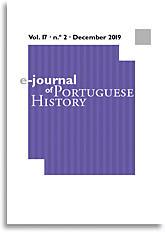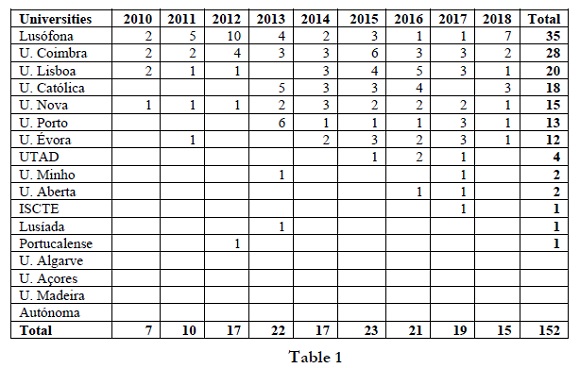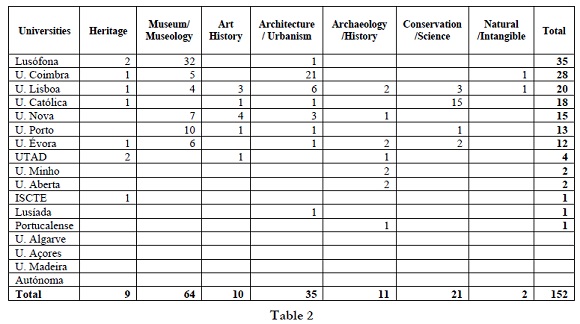
 |
|

Heritage studies: beginnings and possibilities1
Renata Araújo2,3
Abstract
Based on the list of the theses defended in Portuguese universities in the last eight years, a brief assessment is made of the recent developments in the field of Heritage Studies in Portugal and its growth possibilities.
Keywords
Heritage studies; PhD theses; Portugal
Resumo
Tendo por base a lista das teses defendidas nas universidades portuguesas nos últimos oito anos faz-se uma breve apreciação sobre os desenvolvimentos recentes no campo de Estudos de Património em Portugal e suas possibilidades de crescimento.
Palavras-chave
Estudos de património; Teses de doutoramento; Portugal
The introduction of Heritage Studies into the Portuguese academic context is a fairly recent phenomenon. The first university programs, at both undergraduate and master’s degree levels, date from the late 1990s, while most of the PhD programs date from the twenty-first century. However, it is possible to link Heritage Studies to Art History, whose autonomy as a disciplinary field was established prior to this and whose pioneering higher education courses in Portugal date back to the 1970s.
Art History certainly represents one of the origins of Heritage Studies, but this latter subject is presented as a broader “umbrella”, encompassing a wider set of disciplinary fields. Some of these fields are also connected to Art History, such as, for instance, certain areas of specialization or studies of a technical nature, which have gradually claimed, and acquired, greater autonomy in terms of performance and training. This is the case with museum studies and the conservation and restoration of works of art. Also included under the umbrella of Heritage Studies are works linked to the history of architecture and urban planning, which were previously being produced under the scope of Art History or Architecture, as well as a vast set of studies originating from the experiences of theoretical discussions about, or direct intervention in, buildings and ancient urban systems, whether classified or not. Similarly associated to Heritage Studies are some studies and works from the field of Archaeology.
But the amplification of the concept itself-which has been consistently expanding since the second half of the twentieth century, embracing both the natural heritage and the intangible heritage-brings an even broader set of possible relations with other disciplinary areas. Among these, we may include several disciplines from the areas of social and human sciences, such as History, Geography, Anthropology, Sociology and Law, and others still connected to the areas of the natural sciences. In fact, the creation of a field of Heritage Studies not only reflects, but is also directly linked to this process of progressively claiming even greater breadth for the concept of Heritage. This fact is significant and illustrates some interesting, although eventually contradictory, features relating to the genesis of the field itself and to its internal dynamics.
On the one hand, there was clearly an immediate interest in joining together the different disciplinary areas that were already related to Heritage and, besides those, all those areas that can be further linked to it through the amplification of the concept. In some cases, a new field of studies is formed through the expansion of a thematic niche that has begun to claim greater visibility and discursive autonomy. This process normally takes place from within a specific disciplinary area, even if the various different possibilities for interpreting and handling the theme, which may cut across several disciplinary areas, are pointed out. In the case of Heritage Studies, this field of study was, in a way, formed in reverse, by joining together a set of areas that had already partly achieved this autonomy. There is, in this sense, a great vitality and a growth potential intrinsic to the field of Heritage Studies, arising from the many possibilities of study that are created both within each of these areas and through the relationships that can be established between them. Moreover, among the main justifications for the creation of this field of study are its strong interdisciplinarity and its global and intercultural perspective.
Yet, on the other hand, at the root of the creation of this field of study, we can also detect a genuine intention not to investigate only Heritage-related subjects, of whatever kind or scale, nor to discuss only the practices and methods used in dealing with them. The creation of this field of study implies taking a broader and sharper approach that transcends the objects studied and allows for a discussion of the concept itself and the possibility of creating a theory of Heritage. The publication, in 1985, of the book by David Lowenthal, The Past is a Foreign Country, is usually linked to the creation of the field of heritage studies (Lowenthal 1985). It would also be appropriate to associate this book with the publication, in 1984, of the work edited by Pierre Nora, Les Lieux de Mémoire (Nora 1984). There is also a significant amount of other studies, published both before and after these books, which place the very concept of Heritage under constant questioning (Riegl 1903; Babelon and Chastel 1980; Choay 1982; Jeudy 1990). In this sense, there is therefore a huge growth potential for this field of study and, above all, the possibility of greater critical depth in the analysis of the subject-matter. Particularly important are the possibilities that this field of study offers for the discussion of a series of problems linked both to questions related with memory and the uses (ideological, economic, etc.) that have been made of the very concept itself, or that were part of its formative process. It should further be noted that one of the most recent areas of work within this field of study is entitled precisely Critical Heritage Studies (Harrison 2013).
It can be stated with some confidence that, in the last nine years, the field of Heritage Studies in Portugal has presented some signs of vitality. The list published here identifies 152 theses that were defended during this period at different universities. As to the evolution in terms of numbers, at the beginning of the decade, there was a markedly upward trend, with the number of theses rising from seven, in 2010, to 22, in 2013. In 2014, there was a slight decrease, while the highest score occurred in 2015, when 23 theses were defended. Between 2016 and 2018, there was a gradual decrease. It is not easy to understand whether this trend will be maintained or if it will stabilize at this level, especially because there still remains the possibility of further growth through the eventual creation of new courses at universities that do not yet have them.
The overwhelming majority of the theses produced were concentrated in seven universities (from a set of 17). The University of Coimbra, Lisbon Nova University, and the Lusófona University had the most consistent production, presenting theses in each year of the decade. At the University of Lisbon, there was just one year when no theses were presented. At the University of Porto, the Universidade Católica Portuguesa (Catholic University), and the University of Évora, the results became more heavily concentrated from 2013 onwards, and from 2015 onwards at UTAD. At the other universities, the distribution was either occasional (University of Minho, Open University, ISCTE, Lusíada, and Portucalense) or non-existent (University of the Algarve, University of the Azores, University of Madeira, and Universidade Autónoma de Lisboa).
Lusófona University had the highest number of completed theses (35 out of 152), but the distribution of this number over the years has been fairly variable, wavering between one and ten. At the University of Coimbra, the annual numbers fluctuated between two and six; at the University of Lisbon, between zero and five; and, at the Lisbon Nova University between one and three (Table 1).

In terms of regional distribution, there was a clear concentration in Lisbon, where the results of four universities have been added together. But there was also a clear interest demonstrated in Heritage Studies at the Universities of Coimbra, Porto, and Évora, which all have around four PhD programs associated, or associable, with this field of studies.
The PhD programs that were opened in various universities have mostly adopted comprehensive titles. In several cases, they use the generic designation of Heritage Studies, associating these with museum studies, history, art history, history of architecture, conservation and restoration, or archaeology. In other cases, they indicate only one or two of these disciplinary areas in their title. Generally, the titles of the programs do not point to any specific frameworks for the themes to be studied. The only exception is the PhD program in Heritage of Portuguese influence, offered by the Institute for Interdisciplinary Research of the University of Coimbra, which has Architecture and Urbanism and Cultural Studies, as the broader disciplinary areas into which the PhD thesis can be inserted.
Clearly, themes related to museums and museum studies were in the majority among the various theses presented. They corresponded to around 40% of the theses presented in the last nine years at Portuguese universities (64 out of 152)
This result deserves some comments. This proportion partly reflects the current supply of PhD programs on offer, the majority of which, as we have seen, explicitly or implicitly includes this area of study. But it also corresponds to a clear social interest in the overall theme of museums, which, in recent times, has been receiving ever greater attention in the media. Various museum-related subjects have been at the center of public discussions in newspapers and other media, which has included issues relating to the financing of institutions, their management and programming, and the necessity, or not, of building new museums. In several cases, these discussions have given rise to much controversy and to diverging positions being adopted and publicly manifested by the professionals working in this and other areas, as was, for example, the case with the building of the new Coach Museum in Lisbon and, more recently, the proposal for the creation of a supposed Museum of the “Discoveries” which, as is known, has given rise to a series of critical positions being adopted in this area. The ensuing debate has been highly pertinent at a national level, and, interestingly, it was all largely triggered by this proposal to create a museum.
The theses presented in the area of museum studies include largely monographic studies of certain institutions or collections, others that deal with more technical questions relating to heritage management, some that adopt a sociological approach, and others that propose more comprehensive and conceptual interpretations of their subject matter, although these are very few in number. A similar observation can be made in relation to those studies that sought to investigate the very concept of Heritage itself, which were, in fact, not so many in number.
A significant proportion of the listed theses deal with themes related with the history of urbanism and architecture (Table 2). This is the area where the geographical scope of the works is larger, in several cases dealing with the areas and regions of the Portuguese overseas expansion. The works that are listed afforded a certain continuity to a series of research studies that had been carried out in Portuguese universities since the 1990s. This area of study has shown a notable growth in recent years, including, in particular, research relating to achievements recorded under the scope of the colonial empire in the nineteenth and twentieth centuries. We could possibly add to these works other theses that were defended at the Instituto Superior Técnico and at the Faculties of Architecture of Lisbon, Porto, and Évora, on closely related themes.

Themes specifically linked to Art History seem to be in a minority, but there is a clearly increasing trend towards conducting research into the materials and techniques of conservation and restoration. It is important to note that studies relating to intangible and natural heritage are almost completely absent from the list. There was just one study on the iconology of Fado, and another one concerned with rural heritage. It is appropriate to question what might be the reason for the lack of more studies in this area. Is it due to a generically more conservative view of heritage, associating it above all with the monuments of brick and mortar? A lack of interest in some of the disciplinary areas of the humanities (and of the natural sciences) that are necessary for the study of subjects related with Heritage in its various senses and areas of coverage?
A small group of theses, especially in the area of museum studies, were concerned with themes linked to Brazil, which may be related with the growing number of Brazilian students that are currently enrolled at Portuguese universities. However, this does not seem to represent, as such, any clear indication of a greater internationalization on the part of the field of Heritage Studies in Portugal.
It is also important to say that, although, as we have seen, the very formation of the field of Heritage Studies itself allowed for the possibility of potentially interdisciplinary approaches, the majority of the theses listed here were works that were still undertaken in perfectly identifiable disciplinary areas. Furthermore, as we have also seen, there was no great abundance of any critical or conceptual interpretations of the subject area.
But, since this field of study is still relatively recent, the possibilities for growth remain fully open, naturally depending on the specific circumstances and conjunctures of the country and of the investments that are made in it. In particular (but not only), is needed to improve the possibility of the effective absorption of the graduates trained at various institutions.
Please see the (Accompanying Annex)
References
Babelon, Jean-Pierre and André Chastel (1980). La notion de patrimoine. Revue de l’art, 49, Paris: CNRS.
Choay, Françoise (1982). L’Allegorie du Patrimoine. Paris: Éditions du Seuil.
Harrison, Rodney (2013). Heritage: Critical Approaches. London and New York: Routledge.
Jeudy, Henri (ed.) (1990). Patrimoines en folie. Paris: Ed. de la Maison des Sciences de l’Homme.
Lowenthal, David (1985). The Past is a Foreign Country. Cambridge: Cambridge University Press.
Nora, Pierre (ed.) (1984-1992). Les Lieux de Mémoire. 3 vols. Paris: Gallimard.
Riegl, Alois (1903). Der Moderne Denkmalkultus, sein Wesen, sein Entstehung (Einleitung zum Denkmalscutzgesetz). Vienna: Braumuler. (Paris: Le Seuil, 1984).
Notes
1 With an accompanying annex prepared by the editors of e-JPH with the assistance of Elsa Lorga Vila (Graduate of University of Evora; Master’s
Degree in History-Nova University of Lisbon).
2 This article had the support of CHAM (NOVA FCSH / UAc), through the strategic project sponsored by FCT
(UID/HIS/04666/2019).
3 CHAM - Centre for the Humanities and FCHS-UAlg, Portugal. E-Mail: [email protected].
Received for publication: 23 September 2019
Accepted in revised form: 20 October 2019
Recebido para publicação: 23 de
Setembro de 2019
Aceite após revisão: 20 de Outubro de 2019
Copyright
2020, ISSN 1645-6432
e-JPH, Vol. 17, number 2, December 2019